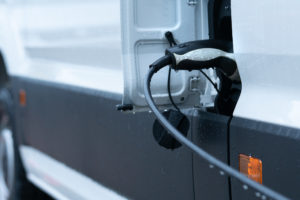While the transition to passenger EVs is well on its way, specific challenges to electrifying commercial transport fleets are making the road rockier.
Road transportation is responsible for around 20% of GHG-emissions in the EU — and 50% of that is attributed to commercial transport. The new normal of e-commerce consumerism since the pandemic has caused an already robust & growing transport sector to grow even more. That means companies in all areas of delivery will continue to increase their fleets. And they need to go electric. In fact, many companies have started to do just that. So why is the commercial transport sector, as many experts predict, still 2 or 3 years behind on EV transition?
Supply & demand and demand
In part 1 of our blog series, we covered the challenges of EV transition in general. There we highlight that supply chain issues are perhaps the main road-hazard for electrifying transportation in the world of 2022. For commercial transport, the story remains the same: eLCV availability challenges.
With the various bans on ICE vehicles in many countries on the horizon, delivery & logistics companies are eager to electrify their fleets. Logistics giants like DB Schenker, Amazon or UPS have already made their orders and are slowly starting to add electric light commercial vehicles (eLCV) and even heavy-duty electric trucks (eHDV) to their depots, route plans and distribution centers. But have they gobbled up the supply or did they just act early? Demand is there, but supply continues to apply the brakes.
Unlike the “straightforward” design requirements of passenger vehicles, transport is not necessarily a one-size-fits-all situation. Specialized business needs require certain specifications in load volumes or vehicle dimensions, charging capacity and battery range requirements, not to mention specific design features. Right now, the choice on the eLCV market is limited and lacks flexibility to cater to unique use cases.
Of course, “customization” usually means higher production costs. Take the example of platforms — that is, the base or frame on which the vehicle chassis is built.
Up to now the big OEMs have built EVs on varying platforms: EV skateboard platforms, more flexible multi-energy platforms, or modified ICE platforms. Popular ICE van models also offered as eLCVs tend to modify existing platforms to fit the EV construction. By using the same re-purposed platforms, OEMs aim to cut investment costs. But modifying ICE platforms sacrifices the efficiency & flexibility of purpose-built EV skateboard platforms — which are ultimately cheaper. This further limits the flexibility to build more specialized eLCV models. Which brings us to the lack of variety on the market — more demand, less supply.
This kind of OEM e-transition production conundrum seems to underscore the need for new thinking and innovation on traditional manufacturing.
But guess what? It’s already here.
Progressive EV production and the rise of the microfactory
A myriad of startup-style electric vehicle makers have popped up recently, producing commercial EVs more specific to specialized transport use cases. Whether producing their own platforms, batteries, onboard software or charging hardware, the focus is on creating technology & bespoke design in-house.
But startups often fail. Building a viable production flow is a challenge and maintaining funds long enough can be a mission impossible. On the other hand, aside from their standard models, OEMs are not doing much use-case specific manufacturing. Even Tesla is holding off on eLCV lines except the much awaited Tesla Semi e-truck — but will it really be out this year Elon?
One solution seems to have emerged: OEMs are funding or acquiring EV startups or starting their own EV ventures and subdivisions. Otherwise, some EV startups are being commissioned to produce exclusive models for big companies or national fleets — a sure-fire way to startup survival!
EV-maker Rivian for example has secured a deal to exclusively produce their EDV 700 van, customized for Amazon’s last-mile fleet in the US.
Still stateside, Brightdrop, a delivery eLCV subsidiary of GM has supplied both Walmart and FedEx electric vans to their fleets.
German Post DHL acquired EV-maker Streetscooter and the resulting Gigabox postal e-vans are already becoming commonplace on Germany’s streets.
More pivotal, alternative production & business models from OEMs are certainly promoting the transport & logistics e-revolution. But to talk true future innovation, look to the EV microfactory concept.
UK-based Arrival is attempting to break the mold with their EV production model. A microfactory challenges traditional manufacturing by creating smaller, localized build-to-order production facilities closer to customers. They focus on in-house technology and more mobile assembly cells that don’t require massive building infrastructure. Arrival builds keeping durability, recycling components and circular economy concepts in mind as a basis for their business model. This is good news for both climate and business sustainability. After some start-ups and downs from going public, pivoting to US markets and reducing model offers, their bespoke transport van is finally going into production.
Electrification planning challenges
The time is now, we want to electrify our fleet! But hold on… where do we start?
The fact is many companies have only a hazy idea of how to get the EV-ball rolling. Many even look at the potential complexity of a totally new set of parameters, sigh deeply and just kick the ball down the road. This is totally understandable, but nonetheless unwise. The wise ones, who have begun to electrify their fleets are a step ahead, but still not necessarily on the ball.
Merely buying trucks and chargers is only a relatively small step on the road to fleet electrification.
What kind and how many eLCVs or e-trucks do we need? Do we need that many charging stations too? Where are we going to charge them? And how much is all this going to cost anyway?? These FAQs are essential questions to ask, but they only scratch the surface.
At PANION we know first-hand the importance of a well-thought-out fleet electrification roadmap. This is a process for before, during and after a company’s EV fleet transition.
We call it…
Strategic Electrification Planning
Companies running delivery fleets need to maintain uninterrupted business operations and utilize their vehicle assets to the maximum. They also want to make any structural changes as cost effective as possible. Simply purchasing electric vehicles & chargers and putting them on routes without a strategy will disrupt all of the above.
Fleet electrification should happen in increments. That means any fleet will be running mixed EV & ICE fleets for a while. During that time, a company learns how to run & charge EVs without hurting operations. It also allows for planned purchasing in line with current vehicle-life durations or leasing contracts.
To know which vehicles to electrify when, analysis of current fleet vehicles, routes, ranges, standing times and electrical infrastructure is paramount.
Most transport fleets are depot-based. So which depot will it be? What is its electrical grid capacity and energy output?
Is the company running last-mile or mid-mile delivery? If so, what kind of ranges are they covering, in how many shifts?
Is operational vehicle & routing data available, like telematics? If not, do they have historical data?
And again, how much and how cost-effective is the total cost of ownership (TCO)?
No wonder that many fleet managers are unwilling to take on such seeming complexity.
This, however, is a challenge for electrifying fleets that PANION can meet.
See PANION Transition to start planning your electrification strategy.
Yes, we build software specifically designed to plan, optimize and manage the operations of the electrification journey — based on data & analysis, a focus on customer needs and implementing smart automation. But we also have expert people to guide you on your way. Let’s talk!
Stay tuned for part 3 in the blog series, where we’ll address the challenges of charging infrastructure.




